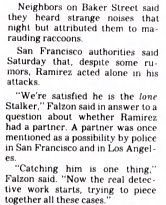
On August 15th, 1985, a burglary occurred in an affluent neighborhood in the Marina District area of San Francisco on Baker Street, at the townhome of dentist Jack Saroyan. While his niece Rosemary Ovian and her friend were sleeping, burglar(s) gained entry to the home, and the house was robbed.
At 11:40 p.m., the Saroyan’s arrived home and found it had been ransacked. The intruder made off with cash, jewelry, a bracelet, a fur stole, cameras, a VCR, and a portable stereo. Inspector Larry Dubour dusted for prints and seemingly found a partial fingerprint on an outside window, but only glove prints were found inside the home. There were no witnesses to the Marina District burglary, and no suspects were identified at the time.

Frank Falzon describes the Marina crime scene in his book, San Francisco Homicide Inspector 5-Henry-7,
“The effort by the burglar to gain entry into the three-story residence showed his tenacity. Sometime after 10:00 p.m., the man first went to the backyard of a house two doors away. He crept down a long driveway on the side of the house and into the backyard. The house was under renovation, and there were old kitchen cabinets and heavy scaffolding strewn about the yard.
He lugged a cabinet and a seven-foot plank over the fence, through the yard adjacent to the Saroyan house, over another fence, and into the Saroyans’ yard. Using the cabinet front and the plank, he fashioned a crude ladder and scaled up to a partially open second-story window. Using a tire iron for leverage – a Toyota tire iron, in fact – he pried open the window and clambered into the kitchen.”
Gaining entry to the Baker Street home was quite an elaborate undertaking. Could this have been a two-or three-person job?

* From Los Angeles Times, Sept.1, 1985

* From Los Angeles Times, Sept.1, 1985
Note Falzon’s statement, “We’re satisfied he is the lone stalker.” Ramirez had not set foot in a courtroom; not a single witness had testified, but the police had already decided he was the Night Stalker, and no one else.
So, how is the Marina burglary connected to the Pan crime? SFPD used the Marina burglary to link the so-called Night Stalker to the Pan crime by making several assumptions and a considerable leap in conclusions. On August 18, 1985, three days after the Marina burglary, Larry Dubour of the San Francisco Police Department (SFPD) was called to the home of Peter and Barbara Pan; both had been brutally attacked, leaving Peter Pan dead and Barbara seriously injured. He noticed the Pan home had been ransacked, similar to the Marina District home. However, he discounted it.
He later spoke with detective Frank Falzon, who “schooled” him on what he had learned from the Los Angeles Night Stalker task force – the Night Stalker does not have a modus operandi – he is everything and nothing – he leaves fingerprints, but he also wears gloves; he ransacks to steal but sometimes takes nothing; sometimes he rapes a wife, sometimes he kills her, but other times he spares her entirely, he is whatever police need him to be at that moment. It was then that the detectives decided the Marina burglar was the same person who committed the Pan crime, which they decided was the infamous Night Stalker. And here we have it – the extent of the detective work that concluded the individual that burglarized the Marina home was the same individual that attacked the Pan’s.
Allegedly, Richards’s fingerprint was on the jewelry from the Baker Street crime. Let’s consider this for a moment. If Richard had indeed stolen the items, the jewelry had changed hands several times in a matter of days. So, it would have had the fingerprints of several different individuals on it, such as Donna Myers, Earl Gregg, Deleen Gregg, and the owner of the jewelry. Yet, law enforcement would have us believe that Richard was the only one to leave an identifiable fingerprint on the window – of all the individuals who touched the stolen jewelry.
During the Los Angeles trial, Donna Myers testified that Richard had arrived alone in San Pablo on August 16– the day before the Pan family was attacked. He gave her a glass jewelry box containing a bracelet (the one later turned over to SFPD by her daughter, Deleen Gregg) and three 14-carat gold rings. She gave one ring to Deleen for her granddaughter. She gave a man’s ring to her son Floyd Dvorak, who lived in Utah and kept the third for herself. Myers said that on one of his August visits – perhaps the day he brought her jewelry – Richard Ramirez came to her house with Armando Rodriguez.
Donna told SFPD how “Rick” was open about how he had acquired cars, microwaves, VCRs, and jewelry, which she gladly accepted and distributed among her relatives. At some point, Ramirez moved from Donna Myers’ home to Armando Rodriguez’s apartment “for one or two nights” – confirmed by friend Ray Garcia – and then back to Myers’ – but there is nothing definite about his movements. Myers claimed Ramirez visited her a second time a few days later and took the rest of the jewelry when he left, although no date for his departure was given.
“On August 16, 1985, Petitioner [Ramirez] came alone to her house. He brought a jewelry box containing jewelry and asked Myers to hold it for him. A few days later, Petitioner returned to Myers’s home to pick up his things. Petitioner gave her the jewelry box, a bracelet, and three rings. She described the box as glass, 6- 8” wide, with a lid. Petitioner took the rest of the jewelry with him when he left. Myers described the jewelry as “14 carat gold, good jewelry.” Myers kept the jewelry box and gave the bracelet to her daughter, Deleen Gregg, and a ring to her granddaughter. She gave a man’s ring to her son, Floyd Joseph Dvorak, Jr., and kept one ring for herself.“
– From 2008 Petition for Writ of Habeas Corpus, Document 14
Accomplices
Did it not cross detectives’ minds that Rodriguez and Garcia might have committed burglaries with Richard? We have access to supporting documents that indicate both had burglarized with Richard in the past. Why would Armando have a burglar stay in his home if he were not one himself? SFPD claimed to have found stolen items from LA Night Stalker victims in Armando Rodriguez’ house, and they alleged the items were given to Armando by Richard.
Where is the proof that the stolen goods from LA were indeed given to Armando by Richard? Did no one entertain the possibility that maybe Armando was involved in the LA burglaries, and that’s how the stolen goods came to be in his possession? Since Richard did not live in San Francisco, how would he have known the best places to rob there? And why did Donna Myers readily accept what she knew was stolen property and gift it to her relatives?


The firefighters were disappointed that they wouldn’t be the ones to catch the Night Stalker-how disappointing indeed! Again, another indication that it was a foregone conclusion it had already been decided Richard Ramirez was the Night Stalker before he had even been arraigned on murder charges.
Several of Richard’s San Francisco acquaintances had stolen property in their possession at the time of his arrest, and they all received immunity from prosecution for having stolen property. The cost of not being prosecuted: Place the blame on Richard Ramirez alone; for this fit the police’s forgone conclusion that Richard was the so-called Night Stalker; the rapist, the murderer, the burglar, the super-criminal that eluded the police from Mission Viejo to San Francisco for several months.
This is the picture we have been painted for decades; this is the story that has been told and inflated repeatedly. No one bothered to look beyond the surface to see what lies beneath. If they had, they might have noticed that this young man, basically homeless, with a drug addiction, who could barely take care of himself, who suffered from traumatic brain injuries plus depression and anxiety, could not have been the Night Stalker. But no one bothered to look because they wanted a raping, murdering Richard Ramirez. He was an easy target, a scapegoat, a patsy.

* A visual representation of the complex web of interactions Richard had in San Francisco.
As the San Francisco court documents are not publicly available and Richard was never brought to trial in San Francisco (the charges were stayed indefinitely), we are left with more questions than answers.

23/10/2023
Kaycee & VenningB

Leave a comment